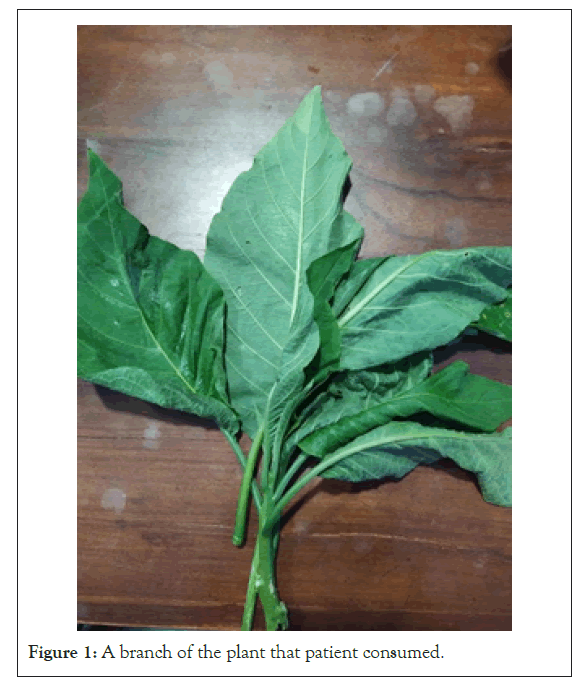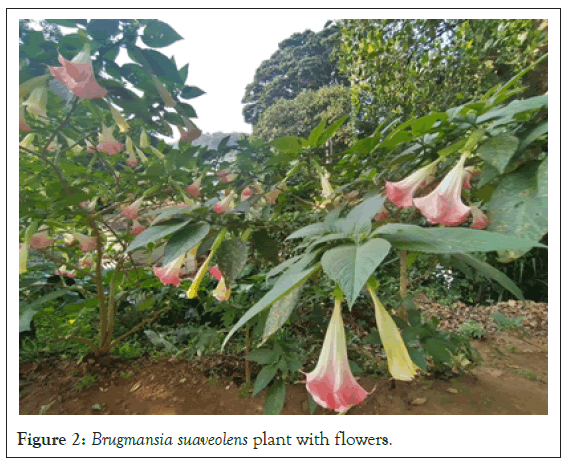
Journal of Clinical Toxicology
Open Access
ISSN: 2161-0495

ISSN: 2161-0495
Case Report - (2021)
Accidental poisoning with Angel’s trumpet (Brugmansia suaveolens) is an uncommon plant poisoning reported in Sri Lanka. Toxic substances like atropine and scopolamine give rise to clinical manifestation of toxicity which is mainly anticholinergic effects. We report a rare case of accidental poisoning of Angel’s trumpet of 73-year-old patient who had clinical manifestations of anticholinergic effects. The patient started his symptoms following consuming leaves of angel’s trumpet accidentally. He developed anticholinergic symptoms such as delirium, altered level of consciousness, dilated pupils and tachycardia. Patient successfully recovered with symptomatic management. We recommend to be aware about uncommon types of plant poisoning and different presentations of their toxic effects, not only for timely diagnosis and treatment of such patients, but also to educate the public about the toxicity of plants in order to prevent morbidity and mortality related to accidental poisoning.
Brugmansia suaveolens; Anticholinergic effects; Toxidrome; Tachycardia
Poisoning is one of the leading causes of deaths in Sri Lanka that accounts for around 80,000 hospital admissions and about 3000 annual deaths [1]. Accidental poisoning with toxic plants is common in pediatric age group and the commonest plant that is implicated with accidental poisoning in Sri Lanka is Jatropha curcas (Barbados Nut/“Weta endaru”) followed by Thevetia peruviana (Oleander/“kaneru”) and Abrus precatorius (Rosary Pea/Paternoster Pea/Wild Licorice/”Olinda”) [2]. Brugmansia suaveolens (Bs), commonly known as “Angel’s trumpet” is a plant native to South America and is now becoming popular as an ornamental plant in Sri Lanka. It has toxic substances which are similar to toxins found in Datura, causing anticholinergic effects on the human body [3]. Although there are a number of internationally reported cases, Bs is a rare cause of accidental poisoning in Sri Lanka and so far, only one reported local case is available [4]. This case report describes a rare case of accidental poisoning with Bs, presenting with anticholinergic symptoms/ anticholinergic toxidrome.
A 73-year-old male from Kandy (Central province) with a past medical history of ischaemic stroke and hypertension was admitted to the hospital with confusion and altered level of consciousness. Patient was living with his wife and it was revealed that she had prepared him a dish out of some ‘herbal leaves’ for the breakfast. He thought the leaves were from Pisonia grandis or locally known as “Watha Bhanga” or “Letta Kochchi” which is consumed as a leafy vegetable. But he has actually picked the leaves from a plant, which was later identified as Bs. or commonly known as “Angel’s trumpet”, mistaking it for Pisonia grandis. He has consumed these leaves with a rice dish. About one hour after having breakfast, he has developed dizziness with alteration of his consciousness. He has not taken any other medications other than his usual medications for stroke and hypertension with recommended dosage. The dizziness has worsened and then he progressively become less conscious. There was no history of witnessed seizures. He had no similar history or psychiatric illnesses in the past. He is a teetotaler and there was no history of illicit drug usage. Patient was admitted to the nearest divisional hospital within the next hour. On admission to the local hospital, the patient has been conscious but delirious. He has been aggressive and was unable to identify people around him including his close family members. Pulse rate and blood pressure have been recorded as 120 per minute and 120/70 mmHg, respectively. Patient was urgently transferred to the nearest tertiary care hospital, National Hospital, Kandy (NHK).
On admission to NH, Kandy, the patient was disorientated with time, place and person and was restless. Glasgow Coma Scale (GCS) was 13 out of 15. Bilateral pupils were dilated with a size of 5 mm. There was no neck stiffness. Patient was afebrile and had a dry skin, dry axillae and dry oral mucosa. He was tachycardic with a heart rate of 108 bpm. Blood pressure was 150/90 mmHg. Respiratory rate was 18 breaths per minute and there were no added lung signs on auscultation. It was revealed that he has not passed urine since morning and the urinary bladder was palpable on abdominal examination. On catheterization, 500 ml of clear urine was drained. Neurological system examination did not reveal any abnormalities including fundus examination. His electrocardiogram showed sinus tachycardia without any other abnormality. His Random blood sugar was 135 mg/dl and arterial blood gas showed a pH of 7.43 and HCO-3 of 23 mmol/l. Non contrast computed tomography scan of the brain was normal. Aspartate Transaminase (AST) was 39 U/L and Alanine Transaminase (ALT) was 45 U/L. Creatine phosphokinase was 237 U/L. Full blood count, urine full report, renal functions and serum electrolytes were within normal range. We did not have the facility of doing urine or blood examination for drug substances such as amphetamine or cocaïne.
According to the history and examination findings clinical diagnosis was made as acute poisoning due to Datura stramonium (“Atthana”) which is a common plant poison that give rise to anticholinergic symptoms. Patient was not given gastric lavage since he was admitted about 5 hours after admission. As the patient was agitated, he was given intravenous (IV) midazolam for sedation. His vital parameters were closely monitored. Patient gradually recovered within the next 12 hours and he did not require any specific antidote use for anticholinergic toxidrome due to atropine toxicity. A branch of leaves of the plant he consumed was got down to ward later and it was specifically identified as Bs (Figure 1).

Figure 1: A branch of the plant that patient consumed.
Patient was discharged the following day after advising him and his family members about the toxicity of the plant. On discharge he was completely free from all the anticholinergic features and was in normal sensorium.
We present a rarely reported case of accidental poisoning of Bs presenting with toxic anticholinergic features in Sri Lanka. Although accidental poisoning is more common in the paediatric population than in adults, according to this case report it is evident that adults should also be made aware regarding accidental and uncommon causes of plant poisoning which can be commonly mistaken for regular day to day consumable leafy plants. Bs, belongs to the family Solanaceae, is a semi woody shrub with a trumpet shaped flower. It is originally native to South American coastal rainforests [5]. But it is grown in Sri Lanka as well as in many other countries as an ornamental plant without awareness about the toxic nature of the plant among the general public (Figure 2).

Figure 2: Brugmansia suaveolens plant with flowers.
Bs contains different chemical compounds such as alkaloids, volatile compounds, coumarins, flavonoids, steroids, and hydrocarbons [6]. Among them the toxic effects are mainly due to atropine and scopolamine [6]. They are found in all parts of the plant but more in seeds [2]. It is shown that flowers of Bs contains atropine and scopolamine 0.79 ± 0.03 mg/g and 0.72 ± 0.05 mg/g respectively, of dry plant weight [6].
Toxic effects are due to post synaptic competitive inhibition of cholinergic muscarinic receptors which results in anticholinergic toxic effects [3]. Clinical features of toxicity include confusion, hallucinations, tachycardia, hyperthermia, dryness, urinary retention, mydriasis and even death [3]. Acute motor axonal neuropathy type Guillain-Barré syndrome was also reported as a rare feature of Bs toxicity [7].
Common causes for plant related poisoning include accidental ingestion, misuse as herbal products, suicidal attempts and deliberate abuse of hallucinogenic plant substances. Accidental poisoning with datura and Bs is by far the most common incidence in Asian countries with wrongful use of traditional medicines. Whereas in Central and North America, Bs toxicity is mostly due to abuse ingestion specially among the younger population [8].
Although plant poisoning is a common clinical emergency, Bs poisoning is not a common cause for plant poisoning in Sri Lanka. A prospective study carried out in Lady Ridgeway Hospital, Colombo for a period of 17 years, showed 243 cases of plant poisoning among children. Jatropha curcas and Ricinus communis were the most common causes of poisoning plants revealed in that study. Dieffenbachia, Adenia palmata, Amanita phalloides and Thevetia peruviana were the other leading causes of poisoning [9]. Another multi-centre prospective study showed 325 cases of plant poisoning reported that Jatropha curcas, Thevetia peruviana, Abrus precatorius and Ricinus communis were the most common causes of poisoning [2]. Both these studies did not describe any case of Bs poisoning. Only one Sri Lankan case report was available in literature describing Bs poisoning. It describes a case of accidental poisoning of Bs that showed significant anticholinergic effects [4]. They have observed a lady who has taken Bs accidentally by including into a herbal drink. Like our patient she also showed anticholinergic features such as altered level of consciousness, mydriasis, dry skin, urinary retention and tachycardia. She was also managed symptomatically and showed a good prognosis [4].
Although it is a rare cause of poisoning in Sri Lanka, Bs poisoning should be considered in a patient who is presenting with anticholinergic symptoms. Confusion/agitation, mydriasis, dry mucosae, and tachycardia were the main signs and symptoms of our patient. Although our patient recovered with supportive management, fatal outcomes are possible with Bs poisoning. Since, Bs is becoming more popular as an ornamental plant, more cases of poisoning can be anticipated in future. The lack of awareness about the toxicity of this plant makes the likelihood of poisoning even worse. Awareness of the public regarding this plant toxicity should be raised and planting this as an ornamental plant should be discouraged.
Citation: Chamara KVDR, Higgoda R, Ellepola K, Premarathne B, Jayasinghe K, Maduwage K (2021) Angel’s Trumpet (Brugmansia suaveolens) Poisoning Presenting with Anticholinergic Toxidrome. J Clin Toxicol. 11:498.
Received: 14-May-2021 Accepted: 28-May-2021 Published: 04-Jun-2021
Copyright: © 2021 Chamara KVDR, et al. This is an open-access article distributed under the terms of the Creative Commons Attribution License, which permits unrestricted use, distribution, and reproduction in any medium, provided the original author and source are credited.